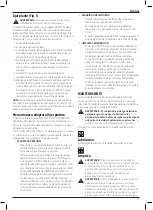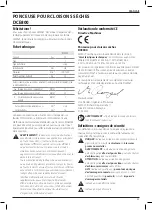
38
EnGLIsH
Sanding Drywall (Fig. I)
WARNING:
To reduce the risk of personal injury, ALWAYS
wear a respirator approved for “Dust and Mist”.
The drywall sander has an articulating sanding head. The head
can swivel in multiple directions, allowing the abrasive pad to
conform to the work surface. This action enables you to sand
the top, middle, and bottom of a wall or ceiling joint without
changing position.
1. Turn the vacuum cleaner switch ON (I).
2. Turn drywall sander switch ON.
3. Position the Drywall Sander lightly against the work surface.
Apply just enough pressure to align the sanding head with
the work surface.
4. Apply additional pressure to engage the abrasive pad on the
work surface. Move the sander in an overlapping pattern to
smooth the drywall compound down to a “featheredge”.
5. Apply ONLY enough pressure to keep the abrasive pad flat
against the work.
6. Keep the sander in constant motion while the abrasive pad is in
contact with the work surface. Use a steady, sweeping motion.
Excessive pressure, stopping the sander on the work, or moving
the sander erratically can cause unacceptable swirl marks and
unevenness in the work surface.
nOTE:
Do not allow rotating abrasive pad to contact sharp
protrusions. Contact with protruding objects (nails, screws,
electrical boxes, etc.), can severely damage the abrasive pad.
Proper hand position requires one hand on the main handle
5
and one hand on the main tube
6
.
Proper Hand Position (Fig. I)
WARNING:
To reduce the risk of serious personal injury,
ALWAYS
use proper hand position as shown.
WARNING:
To reduce the risk of serious personal
injury,
ALWAYS
hold securely in anticipation of a
sudden reaction.
OPERATION
Instructions for Use
WARNING:
Always observe the safety instructions and
applicable regulations.
WARNING:
To reduce the risk of serious personal
injury, turn tool off and disconnect battery pack
before making any adjustments or removing/
D
e
WALT Tool Tag Ready (Fig. H)
Optional Accessory
Your sander comes with mounting holes
15
and fasteners
for installing a
D
e
WALT
Tool Tag. You will need a T15 bit tip to
install the tag. The
D
e
WALT
Tool Tag is designed for tracking and
locating professional power tools, equipment, and machines
using the
D
e
WALT
Tool Connect™ app. For proper installation of
the
D
e
WALT
Tool Tag refer to the
D
e
WALT
Tool Tag manual.
Attaching an AirLock
™
Compatible Dust
Extractor (Fig. F, G)
Your drywall sander is compatible with the
D
e
WALT
AirLock™
connection system. The AirLock™ allows for a fast, secure
connection between the AirLock™ connector
13
and sander's
dust extraction port
7
.
1. Ensure the collar on the AirLock™ connector is in the unlock
position. (Refer to Fig. F.) Align notches
14
on collar and
AirLock™ connector as shown for unlock and lock positions.
2. Push the AirLock™ connector onto the adapter
connector point.
3. Rotate the collar to the locked position.
nOTE:
The ball bearings inside collar lock into slot and
secure the connection.The power tool is now securely
connected to the dust extractor.
nOTE:
The sleeve
17
of the dust extraction port can be
removed if damaged and replaced by the user. The sleeve is
available as an optional accessory and can be replaced using
a screwdriver.
Expanding the Main Tube (Fig. E)
The main tube of the DCE800 can be expanded to various
desired lengths.
• To expand the main tube, release the tube expansion
lever
8
and extend the tube to the desired length.
• Close the tube expansion lever to lock the main tube in
place.
Brush-Type Skirt (Fig. C)
A brush-type skirt
12
surrounds the abrasive pad on the
DCE800. This skirt serves two purposes:
• It extends below the surface of the abrasive pad to prevent
the abrasive from “gouging” the work.
• It helps contain the drywall dust until the vacuum cleaner
pulls it away.
If the skirt is damaged or if it is worn excessively it should be
replaced by a
D
e
WALT
authorised service centre.
installing attachments or accessories.
An accidental
start-up can cause injury.
Precautions to Take When Sanding Paint
Sanding of lead based paint is NOT RECOMMENDED due to the
difficulty of controlling the contaminated dust. The greatest
danger of lead poisoning is to children and pregnant women.
Since it is difficult to identify whether or not a paint contains
lead without a chemical analysis, we recommend the following
precautions when sanding any paint:
1.
PERsOnaL saFETY
-
No children or pregnant women should enter the work
area where the paint sanding is being done until all
clean up is completed.
-
A dust mask or respirator should be worn by all persons
entering the work area. The filter should be replaced
daily or whenever the wearer has difficulty breathing.
See your local hardware store for the proper NIOSH-
approved dust mask.
Содержание XR DCE800
Страница 1: ...DCE800 Final page size A5 148mm x 210mm ...
Страница 3: ...1 Fig A Fig B 7 2 1 5 3 4 6 8 9 1 2 2 1 16 XXXX XX XX 10 ...
Страница 4: ...2 Fig C Fig E Fig G Fig D Fig F Fig H 11 9 12 3 8 14 14 13 7 15 17 ...
Страница 5: ...3 Fig I 6 5 ...
Страница 167: ......
















































